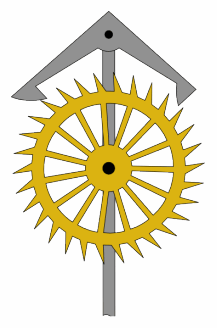Anchor escapement animation 217x328px
This animation shows a typical anchor escapement found in a grandfather clock. The clock has a seconds pendulum, with a period of 2 seconds, so each swing takes one second. The escape wheel has 30 teeth and thus rotates once per minute, so the clock's second hand can be attached to its shaft. The amplitude or width of swing of the pendulum in this example is about 8°, a little wider than many quality anchor clocks, which have amplitudes of 3° - 6°. Of this angle, the "lift" or "drive" angle, the angle of forward swing over which the pendulum receives drive force, is 5°, while the remaining 3° consists of the "recoil".
The animation illustrates one of the disadvantages of the anchor: "recoil", which means the pendulum pushes the escape wheel backwards during part of each cycle. Recoil reverses the clock's gear train all the way back to the driving weight each swing of the pendulum, causing increased wear and inaccuracy.Relevantní obrázky
Relevantní články
Kyvadlové hodinyKyvadlové hodiny jsou typem hodin. Jsou to hodiny, které jako svůj časoměrný prvek používají kyvadlo, kyvné závaží. Výhoda kyvadla pro měření času spočívá v tom, že se jedná o přibližný harmonický oscilátor: kývá se tam a zpět v přesném časovém intervalu závislém na jeho délce a odolává kolísání při jiných rychlostech. Kyvadlové hodiny vynalezl Christiaan Huygens v roce 1656, který se nechal se inspirovat Galileo Galileem. Do 30. let 20. století šlo o nejpřesnější způsob měření času. .. pokračovat ve čtení









